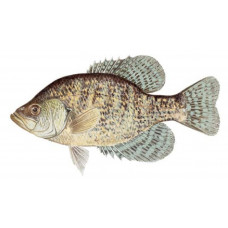Latin name
Pomoxis nigromaculatus
Other names
Speckled perch, calico bass, grass bass, speckled bass, strawberry bass, oswego bass, sacalait, barfish, crawpie, bachelor perch, papermouth, shiner, moonfish; French: marigane noire.
Identification
The black crappie and white crappie are similar in colour, ranging from silvery olive to bronze with dark spots, although on the black crappie the spots are irregularly arranged rather than in seven or eight vertical stripes as on the white crappie. Both species are compressed at the sides and have deep bodies, although the black crappie is slightly deeper and has a large mouth similar to that of the largemouth bass. It also has distinct depressions on its forehead and large dorsal and anal fins of almost equal size. The gill cover ends with a pointed tip rather than an ear-like flap. The best way to tell the two species of crappie apart is to count the spines on the dorsal fin, as the black crappie usually has seven or eight and the white six. The breeding male does not visibly change colour like the white crappie.
Distribution
The black crappie has been so widely introduced into North America that the local range is unclear, although it appears to begin on the Atlantic slope from Virginia to Florida, on the Gulf slope west to Texas, and in the St Lawrence, Great Lakes and Mississippi river basins from Quebec to Manitoba, Canada, south to the Gulf of Mexico.
Habitat
The black crappie prefers cooler, deeper and clearer waters with more aquatic vegetation than the white crappie. These include quiet backwaters, backwater areas, streams, creeks, lakes and ponds. Because crappie swim in schools, anglers who encounter one are likely to find others nearby. Crappie are particularly active in the evenings and early mornings and remain active throughout the winter. A common species, the black crappie, is found in smaller concentrations than the white crappie.
Size
At up to 13 inches long, the black crappie can weigh up to 5 pounds, but is usually less than 2 pounds and is usually caught at a pound or less. It is believed to survive to the age of 10. The world all-tackle record is a 4lb 8oz fish caught in Virginia in 1981.
Life history and Behavior
Spawning takes place in early spring and summer at water temperatures between 62°F and 68°F. These fish spawn in areas of gravel or other soft material and nest in colonies. The males dig nests and the females lay eggs, sometimes in several nests. The eggs hatch in 3 to 5 days and the fry mature sometime between the second and fourth year of life.
Food and feeding habits
Black crappie feed early in the morning on zooplankton, crustaceans, insects, fish, insect larvae, juvenile shad, minnows and small sunfish. Small minnows make up the bulk of the adult diet. In southern waters, gizzard or threadfin shad are the main food, while in northern states insects are the main food. Sgarrias will also eat the larvae of many fish species. They continue to feed in winter and are very active under the ice.
Reproduction
No information
| Classification | |
| Phylum | Chordata |
| Class | Actinopterygii |
| Squad | Perciformes |
| Family | Centrarchidae |
| Genus | Pomoxis |
| Species | P. nigromaculatus |
| Features | |
| Conservation status | Least Concern |
| Habitat | Pelagic |
| Life span, years | 10 |
| Maximum body weight, kg | 2.7 |
| Maximum length, cm | 49 |
| Sailing speed, m/s | No information |
| Threat to people | Edible |
| Way of eating | Predator |

